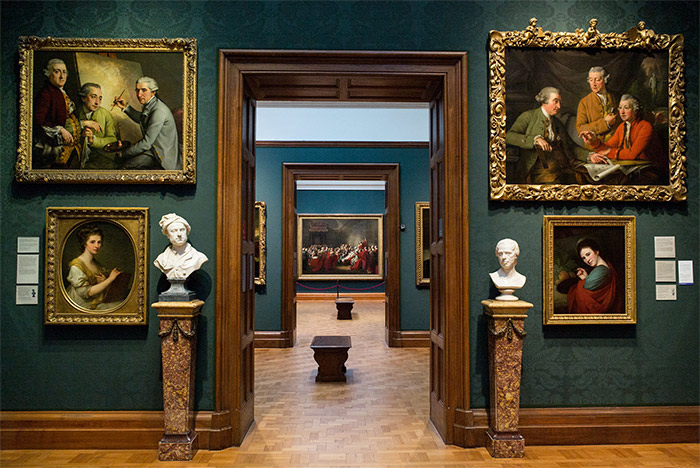What Does a Data Analyst Do At A Museum?
Unknown to many, there is a strong correlation between museums and data. Like other enterprises, museums are financially-driven organizations that need to collect and analyze data to determine revenue earned and enhance customer experience. Why do museums need data analysts?
Museums need data analysts because they serve vital roles that ensure the effective running of their digital platforms. Data analysts identify trend patterns, analyze and synthesize data to enhance the relevance of museums to modern audiences. Data analysts are valuable to the art industry because they attract more clients and solve financial crises.
I will clarify the association between art and data. The modern world is data-driven, and for industries to thrive, they must be willing to adjust and adapt to the rapidly changing times. Yet this may not be easy, hence the need for data analysts in art repositories.
Why is Data Valuable to Museums?
Prominent museums are enriched with cultural diversity and need data analytics to respond to new audience trends. People do not recognize museums as complex organizations, yet they are competitive, financially and mission-driven, and aim to achieve specific goals.
I perceive that there is no clear association between data and visitor attractions. But museums rely on data analytics to determine the best way to serve their clients. The most significant difference between museums and other organizations dependent on data analysis is that archives are considered public establishments and not profit-driven.
Currently, museums are facing external pressure to meet the needs of young generations. Therefore, analytics and applied data are handy for museums because they help steer the unknown future.
What Type of Data Collection Processes Can Museums Use?
Data analysts help museums understand visitors’ behavior by collecting certain information. For instance, a museum can establish whether local and international tourists exhibit similar behavior, get more works and visitors online, and the target audience segments most attracted to specific collections.
Electronic tracking is an ideal way to collect and analyze data; it helps determine visitors’ expenditure, track clients’ movements while in the museum, and the number of people passing through particular doors. However, data analysts must obtain consent from their visitors to not count as a breach of privacy.
Data analysts use numerous data collection methods like indoor location tracking, surveys, social media profiling, Google analytics, and polls. Many data analysts prefer digital means like Google analytics which are easier to use.
Through Google analytics, museums can obtain various information like their potential customers’ sex, age, location, and demographics. Social media platforms effectively establish how much time users spend on a museum’s site and the pages visited more often.
What Are Museums Like In the Age of Big Data?
Today, many museums are open-minded to digitally converting their assemblage and availing themselves of research. Data projects are not common, and this is quite disadvantageous.
Museums have a big responsibility to enhance client loyalty given the COVID-19 pandemic that limits people’s needs. What makes a museum outstanding and attractive to the public? The seizing of digital data enhances unique customer experiences, loyalty, and satisfaction.
Most museums use data to avail vital information to the public, but most do not realize they can use it to understand their audience. Museums can easily contact clients and inquire about their experiences because clients have varying expectations.
What Impact Does Data Analytics Have on Museums?
From my perspective, data analytics is mandatory in museums. When most individuals go to museums, they never exhibit interest in the works they see; instead, they aim to skim through every piece available in the repository. Museums need to be more unorthodox by spending more money and time to elevate visitors’ interest and engagement.
Data-driven decision-making is often valuable since it gives a museum a high competitive edge- this means that museums should embrace data analytics to fulfill their responsibility to the public. It is awry for a few individuals to have a genuine interest in museums because they are public enterprises. Data-driven metrics help inform the mission and goals of museums.
Hiring a data analyst can be quite costly, but applied data is handy in formulating policies and project implementations. The good news is that today, data is easily accessible through attendance records, Google analytics, and financial information.
Raw data is useless and must be processed to reveal helpful information. Data analytics might be costly, but it is worth it because it is the basis of practical insights in all organizations today.
What Do Data Analysts Do?
Data analysts collect and interpret data to solve problems or enhance organizations’ performances. They work in governmental organizations, criminal justice, art, science, business, and medicine.
Data analysis involves identifying appropriate data, collecting and cleaning it in preparation for research, scrutiny, and finally, interpretation.
Data analysts use numerous tools like Microsoft Power BI, SAS, Google sheets, Microsoft excel, python, SQL, and tableau. The technical skills data analysts must have include data visualizations, programming languages, math, statistics, and database tools.
Data analysts working in museums must have specific workplace skills like industry knowledge, communication, and problem-solving. If you are interested in becoming a data analyst at a museum, you must learn about the industry to familiarize yourself with current trends and issues. Critical thinking and speaking skills will give you an upper hand.
What Do Data Analysts Do At A Museum?
Data analysts determine museum market success through solving data crises and making museums more relevant to new audiences. Most museums rely on anecdotes to decide events and programs, yet this should not be the case.
Some museums lack the financial resources and professional development necessary for accreditation. Most people employed in museums lack the knowledge and morale to collect, analyze and interpret data hence the rising need for data analysts.
The use of personal anecdotes in making decisions is quite unpredictable because technology is rapidly changing the industry. Museum professionals cannot evade using digital operation tools in enhancing sustainability. Data analysts help understand, change and evaluate organizational practices with minimal or no risks.
Why do the millennials and individuals of generation Z exhibit tremendously low interest in going to museums? This age group entails a massive percentage of the world’s population. Thus, they should be the museum’s target audience. If young people lose interest in museums, the chances are that the generations to come will manifest the same behavior.
Museums should hire data analysts to enhance inclusivity and vibrancy in art repositories. Since most museums employ staff that are not well trained on data analysis, they should consider hiring professionals or training their staff on data logic and analysis.
Today, only eminent museums hire professional data analysts because the budget for hiring these individuals is relatively high. Examples include the Smithsonian museum, which has an internal team of data analysts to interpret visitors’ data. The British Museum uses Microsoft data scientists to mold client experiences.
Prominent museums have access to more resources than small museums; thus, they are highly likely to benefit from data-driven decision-making. Through research on data analytics, data analysts can evaluate audience engagement, sales development, and ticketing, hence organizational success.
Museum funders are now demanding evidence of organizational impact on the public. How can measurable results be achieved? Relevant museums have professionals who use digital data evidence that helps determine social impact.
It is vital to evaluate the influence of museums on the community to gain funding from NGOs and governmental foundations.
What are the Responsibilities of Data Analysts in Museums?
- Conducting user research and utilizing it to improve the existing organizational practices; for instance, by developing solutions for problems discerned, they can find out why some works receive more attention than others.
- Developing data analytics programs and suggesting new projects to be enacted to elevate user experience and high revenue
- Using mobile technologies to establish the needs of the target audience and the trends in behavioral change
- Training internal stakeholders on how to collect and analyze data in small museums that may not afford to employ many data analysts
- Coming up with continual reports on critical digital metrics and presenting them to firm managers, and other senior personnel
- Analyzing implemented projects to determine their impact on a museum
- Serving as organization referencing sources for data analysis and implementation
- Researching on possible development or enhancement of new projects and channels
- Establishing the effect of digitization on user behavior
How Do Data Analysts Make Use of Data to Enhance Client Experiences and Boost Organizational Earnings?
The biggest obstacle museums face today is using and expanding data analytic tools with little money and time. The solution entails incorporating external data sets like geographic, demographic, and psychographic information, enabling museums to pay dividends without necessarily relying on consultation or staff.
Data analytics enable museums to communicate with their audience. Some museums do not engage in systematic qualitative analysis. They should rely on data and its potential to influence anecdotal inferences. Data visualization is essential in communicating insights, therefore building museums’ strength in logical reasoning.
Museums must practice data analytics- it does not necessarily need to be perfect. Most organizations believe in perfection, yet this leads to delays which might do away with the value of expenditure in analytics.
All museum organizations can use data because it is easily accessible. There is vast information on past events and current happenings that help organizational management understand how contemporary art repositories work. I believe applied data can change the museum industry for the better good.
Museums can use numerous digital devices to collect data on client preferences, including audio guides, mobile applications, and touch screens.
Audio guides are sources of audible information on visitors’ progress. They help reconstruct customers’ routes, and the analysis of the data collected is useful in determining the information most consumed and the works that spark the most attention.
Mobile applications are also handy in monitoring the flow of visitors in museums. Data analysts can discern the most requested exhibits through the apps and ensure clients receive their requests.
Touch screens are a pretty significant source of data because they showcase the screens most visited by clients, the time spent looking for available information on an art piece, and the methods clients use to search on-screen.
Data analysts explore customers’ behavior to know a specific museum’s target audience and develop a good loyalty strategy to enhance clients’ trust and allegiance.
Are there Museums that Have Benefited From Informed Decision Making?
Many prominent museums formulate their strategies depending on the information conveyed by their data analysts. These evidence-based scenarios demonstrate the essence of applied data in the valorization of museums;
- The Fenimore Museum of art in Cooperstown, New York, could not discern the relationship between ticket sales and media advertisement. The solution was to compare the postal codes of sold tickets with geographic ads through data analytics. The proposed implementation resulted in an increase in the number of clients from locations where radio advertisement of the firm was high.
- The Madrid Reina Sofia National Museum could not understand the visitation trends for some art exhibitions. The finding was that a significant percentage of the visitors were from abroad, mainly first world nations.
- The Chicago Art Institute wanted to increase its revenue by attracting more visitors. It used data analytics to track the visitation of clients and the time they spent at specific exhibitions. The museum chose to promote the galleries with more visitors, thus increasing profits.
How Can You Become A Museum’s Data Analyst?
You should have specific qualifications to be hired as a museum data analyst. They include;
- Bachelor’s degree in any analytical field like Economics and Mathematics
- The technical know-how of navigating social media platforms
- Good communication skills
- Good data visualization skills
- The ability to multitask and willingness to learn
- Good organizational skills
- Ability to understand and interpret large data sets
- High morale and good professional conduct
- Good writing skills for drafting data analytics reports
- High proficiency in the use of Microsoft Excel, SQL, python, tableau, and Google sheets
- Ability to make good data-informed decisions that enhance organizational success
In closing, I hope you understand why museums need data analysts. If this is your desired career, do not hesitate to send job applications to any museums that may be hiring. A good data analyst is valuable to a firm and receives high compensation for the excellent work done.
References
https://medium.com/museum-tech-trends/5-reasons-for-museum-data-analytics-14b777c12d2a
https://searchbusinessanalytics.techtarget.com/feature/Museums-and-data-A-powerful-combination
https://arenametrix.com/en/marketing-museums/
https://nysmuseums.org/MANYnews/7300085







